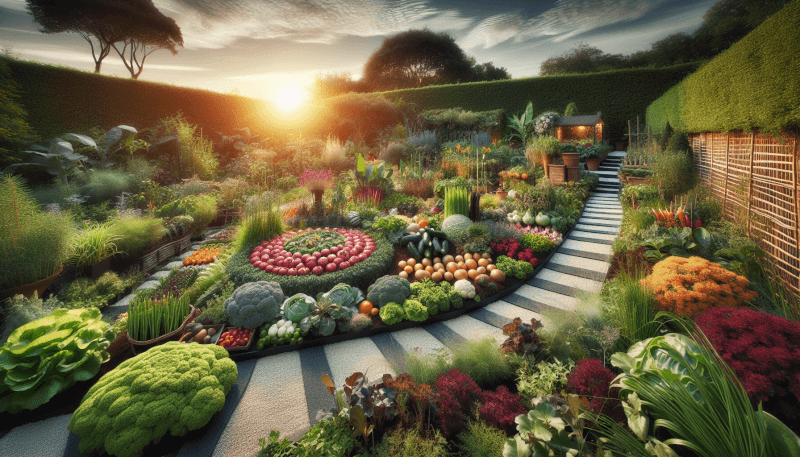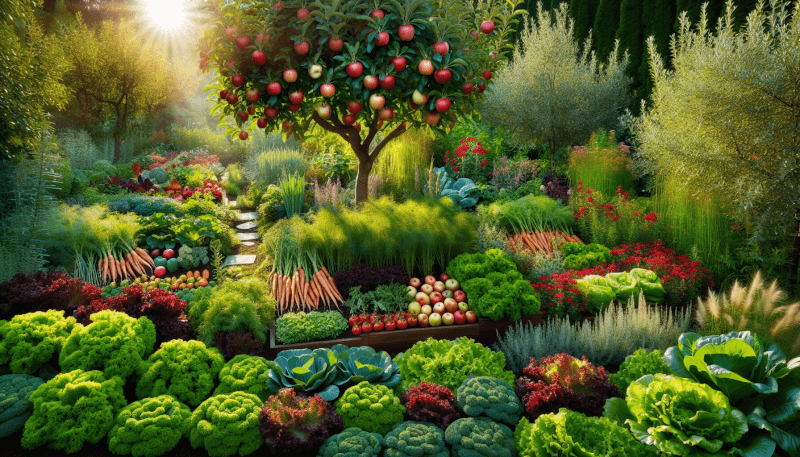Imagine stepping out into your backyard and being greeted by a breathtaking scenery of vibrant colors, lush greenery, and enticing aromas. Now, envision being able to pluck fresh, organic ingredients straight from your garden to create mouthwatering and nutritious dishes. In this article, we will explore the art of creating a beautiful edible landscape that not only enhances the aesthetics of your outdoor space but also provides you with a bountiful supply of ingredients for your healthy recipes. Get ready to embark on a journey of discovering the joys of gardening and cooking, all in one harmonious experience.
Choosing the Right Location for Your Edible Landscape
Considering sun exposure
When choosing the location for your edible landscape, it is crucial to consider the amount of sun exposure the area receives. Most edible plants require at least six hours of direct sunlight each day to thrive. Observe the area at different times of the day to determine how much sun it receives. Keep in mind that nearby trees or structures can cast shade and affect sunlight availability. Select a location that provides adequate sun exposure for the types of edible plants you wish to grow.
Assessing soil quality
The quality of the soil plays a vital role in the success of your edible landscape. Assess the soil quality by performing a simple soil test. This will determine the pH level and help you understand the soil’s fertility. Most edible plants prefer a slightly acidic soil with a pH range of 6.0 to 7.0. Test kits are readily available at gardening stores or through online suppliers. If your soil lacks nutrients or has an imbalanced pH, you may need to amend it to create the ideal conditions for your plants.
Ensuring proper drainage
Good drainage is essential for the health of your edible landscape. Plants can suffer from waterlogged soil, which can lead to root rot and other diseases. Assess the drainage of the selected location by observing how water behaves after rainfall. If you notice pooling water or slow drainage, it may be necessary to improve the drainage. This can be accomplished by adding organic matter such as compost or by creating raised beds. Ensuring proper drainage will prevent waterlogging and promote healthy plant growth.
Taking into account space availability
Consider the available space when choosing the location for your edible landscape. Evaluate the area’s dimensions and determine whether it is large enough to accommodate the types of plants you wish to grow. Some plants, such as fruit trees or sprawling vegetables, require ample space to thrive. Additionally, consider any existing structures or obstacles that may restrict the growth of your plants. Take into account the growth habits of your chosen plants and ensure they will have sufficient space to develop and flourish.
Selecting the Plants for Your Edible Landscape
Deciding on a theme or style
Before selecting the plants for your edible landscape, it is essential to decide on a theme or style that aligns with your preferences. Whether you prefer a formal garden, a wildflower meadow, or a combination of various styles, determining the overall look and feel will guide your plant selection. Consider the colors, textures, and heights of the plants that will contribute to the desired theme. This will create a cohesive and visually appealing edible landscape.
Researching suitable plants for your climate
While many edible plants can thrive in a range of climates, it is crucial to research which plants are suitable for your specific region. Consider the average annual temperature range, frost dates, and local weather conditions. Different plants have different temperature preferences and may not tolerate extreme temperatures or frost. By choosing plants that are well-suited for your climate, you increase the chances of a successful edible landscape.
Choosing a variety of plants
To create an engaging and diverse edible landscape, choose a variety of plants with different colors, shapes, and textures. Select a mix of herbs, vegetables, fruits, and edible flowers. This variety will not only add visual interest but also provide a wide range of flavors for your culinary creations. Consider plants that have different growth habits, such as plants that climb, plants that spread, or plants that form compact bushes. This variety will create a dynamic and visually appealing edible landscape.
Considering the seasonality of plants
When selecting plants for your edible landscape, it is crucial to consider their seasonality. Some plants thrive in specific seasons, while others can be grown year-round. Research the planting and harvesting seasons of the plants you wish to grow. By choosing a mix of plants that can be harvested at different times throughout the year, you can ensure a continuous supply of fresh produce. Additionally, consider incorporating winter-hardy plants or utilizing season-extending techniques, such as cold frames or hoop houses, to extend the growing season.

Designing and Planning Your Edible Landscape
Creating a rough sketch of your landscape
Before diving into the specifics of plant placement, start by creating a rough sketch of your edible landscape. This will help you visualize the overall layout and determine the best use of your available space. Consider the existing structures, pathways, and focal points in your backyard and incorporate them into your design. Sketch out different areas for specific purposes, such as a vegetable garden, an herb garden, or a fruit tree orchard. This sketch will serve as a blueprint for your edible landscape design.
Determining the layout and arrangement of plants
Once you have a rough sketch of your landscape, it’s time to determine the layout and arrangement of your plants. Consider the height, growth habits, and spacing requirements of each plant. Tall plants can be positioned at the back to provide a backdrop, while smaller plants can be placed in the front. Keep in mind the mature size of each plant and ensure they have enough space to grow and receive adequate sunlight. Aim for a harmonious arrangement that balances aesthetics and functionality.
Considering the needs of each plant
Every plant has specific needs and requirements for optimal growth. Consider the needs of each plant when designing your edible landscape. Some plants, such as tomatoes or peppers, thrive in full sun, while others, like lettuce or spinach, prefer partial shade. Additionally, take into account the soil requirements, watering needs, and any additional care tips for each plant. By grouping plants with similar needs together, you can simplify maintenance and ensure each plant receives the proper care.
Incorporating pathways and focal points
To enhance the functionality and aesthetics of your edible landscape, consider incorporating pathways and focal points. Pathways can provide access to different areas of your landscape, making maintenance and harvest more convenient. They also add structure and visual interest to the overall design. Focal points, such as a seating area, a decorative trellis, or a water feature, can create visual focal points and serve as gathering spaces in your edible landscape. These elements add personality and charm to your design.
Preparing the Soil for Planting
Clearing the area of debris and weeds
Before planting your edible landscape, it is crucial to clear the area of debris and weeds. Remove any rocks, branches, or other unwanted materials that may hinder plant growth. Additionally, pull out any existing weeds to prevent competition for nutrients and space. Clearing the area will create a clean and conducive environment for your plants to thrive.
Testing the soil pH and fertility
To ensure optimal soil conditions, it is recommended to test the pH and fertility of your soil. This will provide valuable information about the nutrient levels and acidity/alkalinity of the soil. Soil testing kits can be purchased at gardening stores or online, and they are easy to use. Based on the test results, you can adjust the soil pH and fertility by adding organic matter, such as compost or well-rotted manure. This will create a nutrient-rich environment for your plants.
Amending the soil with organic matter
Adding organic matter to your soil is an essential step in preparing it for planting. Organic matter improves soil structure, enhances moisture retention, and promotes nutrient availability. Incorporate well-rotted compost, leaf mold, or aged manure into the soil to increase its organic matter content. This will help create a rich and fertile soil that supports healthy root development and vigorous plant growth.
Mulching to retain moisture and suppress weeds
Mulching is another crucial step in preparing your soil for planting. Applying a layer of organic mulch, such as straw, wood chips, or shredded leaves, helps retain moisture, suppress weed growth, and regulate soil temperature. Mulch also acts as a natural barrier against erosion and creates a tidy and finished look to your edible landscape. Be sure to keep the mulch a few inches away from the stems of plants to prevent rotting or pest infestations.

Planting and Caring for Your Edible Landscape
Starting with healthy and quality plants
When it comes to planting your edible landscape, it’s important to start with healthy and quality plants. Purchase plants from reputable nurseries or garden centers that offer healthy and disease-free specimens. Inspect the plants for any signs of pests or diseases before bringing them home. Healthy plants will have a better chance of establishing themselves and thriving in your edible landscape.
Properly spacing and planting the crops
Proper spacing and planting are crucial for the optimal growth and development of your plants. Consider the mature size and growth habits of each plant to determine the appropriate spacing. Overcrowding can lead to competition for resources and hinder the plants’ growth, while spacing them too widely may result in wasted space. Plant each crop at the appropriate depth and follow the recommended planting instructions for each plant. This will promote healthy root development and ensure the plants have sufficient room to grow.
Providing adequate water and irrigation
Watering is a vital aspect of caring for your edible landscape. Provide your plants with adequate water to promote healthy growth and prevent them from drying out. The watering needs may vary depending on the plant species, soil type, and weather conditions. Consider installing an irrigation system, such as drip irrigation, to ensure consistent and efficient water delivery. Monitor the moisture levels of the soil and adjust your watering schedule as needed to prevent overwatering or underwatering.
Implementing organic pest and weed control methods
To maintain a healthy and thriving edible landscape, it is important to implement organic pest and weed control methods. Regularly inspect your plants for signs of pests, such as aphids or caterpillars, and take appropriate action to control them. Utilize natural pest control methods, such as companion planting or introducing beneficial insects, to minimize pest damage. Additionally, stay vigilant and promptly remove any weeds to prevent them from competing with your plants for resources.
Maintaining and Harvesting Your Edible Landscape
Regularly pruning and trimming plants
Regular pruning and trimming are essential for maintaining the shape and health of your plants. Prune any dead or damaged branches to encourage new growth and prevent the spread of diseases. Trim back overgrown plants to maintain a tidy appearance and promote airflow. Additionally, consider pruning techniques that promote fruit production, such as thinning out branches to improve light penetration. Regular maintenance will keep your edible landscape looking neat and ensure optimum plant health.
Fertilizing and replenishing soil nutrients
To keep your plants healthy and productive, it is important to fertilize and replenish the soil nutrients. Apply organic fertilizers, such as compost, well-rotted manure, or organic liquid fertilizers, throughout the growing season. These fertilizers provide essential nutrients, including nitrogen, phosphorus, and potassium, that support the plant’s growth and development. Regularly feeding your plants will promote robust growth, enhance fruiting, and provide the necessary nutrients for a bountiful harvest.
Monitoring for pests and diseases
Regular monitoring for pests and diseases is crucial in maintaining the health of your edible landscape. Keep a close eye on your plants and promptly address any signs of pest infestation or disease. Early detection and intervention can prevent the spread of pests or diseases to other plants and minimize damage. Regularly inspect the leaves, stems, and fruit for any abnormalities, and take appropriate action, such as using organic pest control methods or pruning affected areas, to protect your plants.
Harvesting fruits, vegetables, and herbs at their peak
One of the joys of having an edible landscape is the opportunity to harvest fresh and flavorful produce. Harvest your fruits, vegetables, and herbs at their peak of ripeness to enjoy the best flavors and nutritional value. Read up on the specific harvesting instructions for each plant to ensure you pick them at the right time. Handle the harvested produce gently to prevent bruising or damage. Enjoy the bountiful rewards of your efforts by incorporating the freshly harvested ingredients into your favorite healthy recipes.

Creating a Focal Point with Edible Ornamentals
Adding edible flowers for color and beauty
Adding edible flowers to your edible landscape can provide a pop of color and beauty. Many flowers are not only visually stunning but also have edible petals that can be used in salads, desserts, or as garnishes. Incorporate vibrant flowers such as marigolds, pansies, or nasturtiums to add interest and diversity to your edible landscape. Be sure to research the edible properties and flavors of each flower before consuming them.
Incorporating ornamental grasses and foliage plants
To enhance the visual appeal of your edible landscape, consider incorporating ornamental grasses and foliage plants. Grasses, such as ornamental varieties of bamboo or fountain grass, can add texture and movement to your design. Foliage plants with unique colors or patterns, such as ornamental kale or Swiss chard, can create visual interest and contrast. These ornamental additions will elevate the overall aesthetic of your edible landscape while still providing edible elements.
Utilizing decorative trellises and structures
Decorative trellises and structures not only add visual interest but also provide support for climbing plants in your edible landscape. Incorporate trellises, arbors, or archways to create vertical elements and maximize space utilization. Train climbing plants such as tomatoes, cucumbers, or beans on these structures, adding beauty and functionality to your design. Take advantage of the vertical space in your edible landscape by utilizing these decorative elements.
Creating a beautiful container garden
Container gardening is a versatile option for including edible plants in your landscape, especially if you have limited space or a paved area. Choose attractive containers in various sizes, shapes, and colors that complement your overall design. Plant herbs, salad greens, or compact fruiting plants, such as strawberries, in these containers. Place them strategically throughout your landscape to add visual interest and create a mobile garden that can be easily rearranged.
Enhancing Your Edible Landscape with Hardscaping
Integrating stone or brick walkways
Integrating stone or brick walkways into your edible landscape adds charm and functionality. Pathways made of natural stones or bricks create a defined route through your garden, encouraging exploration and making maintenance easier. Use various patterns and textures to match the overall theme of your landscape. These pathways not only provide a designated area to walk but also enhance the aesthetics of your edible landscape.
Building raised beds or planter boxes
Building raised beds or planter boxes is an excellent option for optimizing space utilization and improving soil conditions. Raised beds provide a controlled environment for planting, allowing you to customize soil composition and water drainage. They also offer accessibility for planting, maintaining, and harvesting without the need to bend or kneel. Planter boxes can be placed strategically throughout your landscape, adding height and creating visual interest. Utilize these hardscaping elements to enhance the functionality and structure of your edible landscape.
Installing a drip irrigation system
Installing a drip irrigation system is a convenient and efficient way to ensure consistent and targeted watering in your edible landscape. Drip irrigation delivers water directly to the root zone of plants, minimizing evaporation and water waste. It also prevents water from splashing onto leaves, reducing the risk of disease. A well-designed drip irrigation system can save time and water while keeping your plants adequately hydrated throughout the growing season.
Adding seating areas and outdoor kitchen
To fully enjoy your edible landscape, consider adding seating areas and an outdoor kitchen. Create a cozy seating area where you can relax and admire the beauty of your edible landscape. Install a patio, deck, or a pergola to provide shade and shelter. An outdoor kitchen equipped with a grill, sink, and food preparation area allows you to fully utilize your harvest in the preparation of healthy meals. These additions transform your edible landscape into a functional and inviting outdoor living space.

Considering the Maintenance and Longevity
Being realistic about the time commitment
Maintaining an edible landscape requires a certain level of time commitment. Be realistic about the amount of time you can dedicate to maintenance tasks such as watering, pruning, and fertilizing. Consider your schedule and availability to ensure you can provide adequate care for your plants. If you have limited time, choose low-maintenance plant varieties or simplify the design to minimize maintenance requirements. Being aware of the time commitment will help you create an edible landscape that fits your lifestyle.
Monitoring and adjusting for plant growth
As your edible landscape evolves, it is important to monitor and adjust for plant growth. Plants may outgrow their allocated space or shade out neighboring plants. Regularly assess the growth habits of your plants and make necessary adjustments to ensure each plant has enough room to thrive. This may involve pruning, transplanting, or removing certain plants. Monitoring and adjusting for plant growth will help maintain a balanced and harmonious edible landscape.
Applying seasonal maintenance tasks
Seasonal maintenance tasks are essential for the long-term health and productivity of your edible landscape. This includes seasonal pruning, fertilizing, and cleaning up fallen debris. Before each season, create a checklist of specific tasks that need to be performed to ensure your plants receive the care they need. Taking the time to perform these seasonal maintenance tasks will help promote healthy growth, minimize pest and disease issues, and ensure that your edible landscape remains vibrant and productive.
Planning for the future growth and expansion
When designing your edible landscape, it is important to consider future growth and expansion. Anticipate the growth habits and eventual size of your chosen plants. This will help you determine appropriate spacing and ensure that your landscape will not become overcrowded as the plants mature. Additionally, consider the potential for future expansion or introducing new plant varieties. Planning for the future growth and expansion will allow your edible landscape to evolve and adapt over time.
Enjoying the Fruits of Your Edible Landscape
Experimenting with creative healthy recipes
One of the greatest joys of having an edible landscape is experimenting with creative and healthy recipes using your homegrown produce. Explore new flavors, textures, and combinations to create unique dishes that highlight the freshness of your harvest. Incorporate herbs, vegetables, fruits, and edible flowers into salads, stir-fries, smoothies, and desserts. Let your imagination run wild in the kitchen as you enjoy the delicious fruits of your edible landscape.
Hosting gatherings and sharing your harvest
Invite family and friends to experience the beauty and bounty of your edible landscape by hosting gatherings and harvest events. Create a welcoming atmosphere where guests can appreciate the flavors and freshness of homegrown produce. Share your knowledge and passion for gardening, inspiring others to create their own edible landscapes. These gatherings not only foster a sense of community but also provide an opportunity to showcase the hard work and dedication you’ve put into your edible landscape.
Preserving excess produce through canning or freezing
If you find yourself with an abundance of produce from your edible landscape, consider preserving it through canning or freezing. This allows you to enjoy the flavors of your harvest throughout the year. Research the best preservation methods for each type of produce and follow proper food safety guidelines. Canning fruits and vegetables, making homemade jams or pickles, or freezing herbs and vegetables are great ways to extend the enjoyment of your edible landscape beyond the growing season.
Continuing to learn and improve your edible landscape
Creating an edible landscape is an ongoing journey of learning and improvement. Continue to expand your knowledge through books, online resources, and gardening communities. Stay curious and experiment with new plant varieties, techniques, and designs. Reflect on the successes and challenges of each growing season and use them as opportunities for growth and improvement. Your edible landscape will continue to evolve as you learn and apply new insights, resulting in a more beautiful and productive garden.



